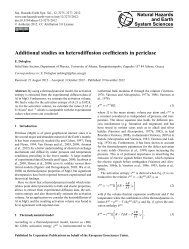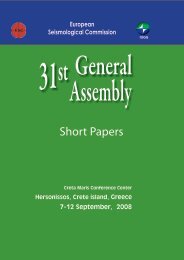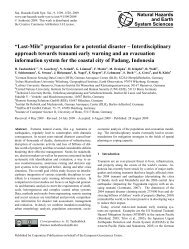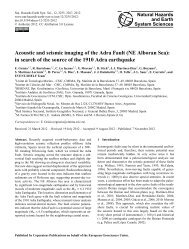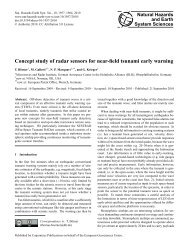implications for permafrost degradation and slope instability in the ...
implications for permafrost degradation and slope instability in the ...
implications for permafrost degradation and slope instability in the ...
Create successful ePaper yourself
Turn your PDF publications into a flip-book with our unique Google optimized e-Paper software.
R. P. Daanen et al.: Rapid movement of frozen debris-lobes 1523<br />
2 Study area<br />
The frozen debris-lobes we studied are located <strong>in</strong> <strong>the</strong><br />
south-central Brooks Range of Alaska, USA. Based on<br />
historical repeat photography <strong>and</strong> lichenometry, Ellis <strong>and</strong><br />
Calk<strong>in</strong> (1979) suggest that <strong>the</strong> most rapid retreat of alp<strong>in</strong>e<br />
glaciers <strong>in</strong> <strong>the</strong> area occurred after ca. 1870, followed by a deceleration<br />
after <strong>the</strong> mid-1900s (Ellis <strong>and</strong> Calk<strong>in</strong>, 1984). Lake<br />
varves, <strong>in</strong> a glacially fed lake <strong>in</strong> <strong>the</strong> central Brooks Range,<br />
<strong>in</strong>dicates that this portion of <strong>the</strong> Brooks Range has experienced<br />
atmospheric warm<strong>in</strong>g of 3.7 to 5.0 ◦ C dur<strong>in</strong>g <strong>the</strong> summer<br />
months s<strong>in</strong>ce <strong>the</strong> Little Ice Age as suggested by Bird et<br />
al. (2009) <strong>and</strong> by Evison et al. (1996), who studied glacial retreat<br />
dynamics. In a review paper, Molnia (2007) confirmed<br />
this overall pattern of glacial retreat s<strong>in</strong>ce <strong>the</strong> late 19th century<br />
<strong>for</strong> <strong>the</strong> Brooks Range, which is <strong>in</strong> l<strong>in</strong>e with that of o<strong>the</strong>r<br />
Alaskan mounta<strong>in</strong> ranges. Nolan et al. (2005) provide an<br />
overview of glacier th<strong>in</strong>n<strong>in</strong>g over <strong>the</strong> period from 1956 to<br />
2003 <strong>for</strong> <strong>the</strong> McCall glacier nor<strong>the</strong>ast of our research area <strong>in</strong><br />
<strong>the</strong> Brooks Range. They found an <strong>in</strong>crease <strong>in</strong> th<strong>in</strong>n<strong>in</strong>g from<br />
0.35 m yr −1 be<strong>for</strong>e 1993 to 0.47 m yr −1 <strong>the</strong>reafter.<br />
Ellis <strong>and</strong> Calk<strong>in</strong> (1984) also suggest that rock glaciers,<br />
now present <strong>in</strong> cirques of <strong>the</strong> central Brooks Range, were<br />
probably <strong>in</strong>itiated by <strong>in</strong>creased mass wast<strong>in</strong>g from oversteepened<br />
valleys <strong>and</strong> cirque walls after late glacial deglaciation.<br />
Ellis <strong>and</strong> Calk<strong>in</strong> (1979) report that most of <strong>the</strong> active<br />
rock glaciers are found north of <strong>the</strong> cont<strong>in</strong>ental divide <strong>and</strong><br />
at altitudes higher than 1350 m. a.s.l., with lower limits <strong>for</strong><br />
tongue-shaped rock glacier snouts at 1200 m. a.s.l. <strong>for</strong> <strong>in</strong>active<br />
<strong>for</strong>ms <strong>and</strong> at 1300 m. a.s.l. <strong>for</strong> active <strong>for</strong>ms. Hamilton<br />
(1978a, b; 1979a, b; 1980, 1981) mapped <strong>the</strong> surficial geology<br />
of <strong>the</strong> central Brooks Range. He recognised <strong>and</strong> mapped<br />
a variety of mass wast<strong>in</strong>g features <strong>in</strong> <strong>the</strong> region <strong>in</strong>clud<strong>in</strong>g<br />
rock glaciers, talus cones, rock slides, slush flow deposits as<br />
well as open system p<strong>in</strong>gos, o<strong>the</strong>r frost mounds <strong>and</strong> aufeis,<br />
<strong>in</strong>dicat<strong>in</strong>g groundwater flow. Us<strong>in</strong>g aerial photography <strong>and</strong><br />
helicopter traverses, Hamilton was <strong>the</strong> first to map <strong>the</strong> location<br />
<strong>and</strong> widespread occurrence of lobate mass wast<strong>in</strong>g features<br />
<strong>in</strong> <strong>the</strong> central Brooks Range that are dist<strong>in</strong>ct from <strong>the</strong><br />
previously described rock glaciers, due to <strong>the</strong>ir material content,<br />
location, shape <strong>and</strong> vegetation cover. In his maps he<br />
named <strong>the</strong>m flow slides.<br />
Frozen debris-lobes FDL-A, -B <strong>and</strong> -C exam<strong>in</strong>ed <strong>in</strong> this<br />
paper are located <strong>in</strong> <strong>the</strong> south-trend<strong>in</strong>g valley of <strong>the</strong> Dietrich<br />
River (Fig. 1), a short distance south of <strong>the</strong> Cont<strong>in</strong>ental<br />
Divide. They are located near <strong>the</strong> Dalton Highway<br />
transportation corridor (see Fig. 1, lower <strong>in</strong>set), about 65 km<br />
north of Coldfoot <strong>and</strong> 170 km south of Deadhorse. Most<br />
of our detailed observations are from a frozen debris-lobe<br />
(site FDL-A) located at 67 ◦ 48.669 ′ N/149 ◦ 49.185 ′ W, which<br />
is also <strong>the</strong> frozen debris-lobe closest to <strong>the</strong> Dalton Highway.<br />
Based on a 0.5-m resolution WorldView-1 satellite image<br />
from 24 August 2008 <strong>the</strong> lobe front was approximately 75 m<br />
away from <strong>the</strong> Dalton Highway <strong>and</strong> 310 m from <strong>the</strong> Trans<br />
Alaska Pipel<strong>in</strong>e System (TAPS), which is buried <strong>in</strong> alluvial<br />
sediment <strong>in</strong> this section. Parallel<strong>in</strong>g <strong>the</strong> highway is <strong>the</strong> Dietrich<br />
River, which provides <strong>the</strong> ma<strong>in</strong> dra<strong>in</strong>age <strong>for</strong> <strong>the</strong> region.<br />
The study area is mapped as cont<strong>in</strong>uous <strong>permafrost</strong> (Jorgenson<br />
et al., 2008), however, <strong>permafrost</strong> <strong>in</strong> <strong>the</strong> valleys of<br />
<strong>the</strong> sou<strong>the</strong>rn Brooks Range is relatively warm (−1.0 ◦ C at<br />
24 m depth; measured <strong>in</strong> 2010) (CADIS, 2010) <strong>and</strong> shallow.<br />
W<strong>in</strong>ter snow pack <strong>in</strong>sulation causes warmer subsurface conditions<br />
relative to <strong>the</strong> air temperature. Comb<strong>in</strong>ed, <strong>the</strong>se characteristics<br />
result <strong>in</strong> <strong>permafrost</strong> that is highly susceptible to<br />
<strong>degradation</strong> <strong>and</strong> active layer deepen<strong>in</strong>g. Slope <strong>and</strong> aspect<br />
also contribute to <strong>the</strong> difference between warmer <strong>and</strong> cooler<br />
sites, with north fac<strong>in</strong>g <strong>slope</strong>s be<strong>in</strong>g predom<strong>in</strong>antly cooler;<br />
this is evident from <strong>the</strong> altitud<strong>in</strong>al tree l<strong>in</strong>e, which varies<br />
strongly between <strong>slope</strong> aspects <strong>in</strong> this region. In addition,<br />
vegetation <strong>and</strong> presence or absence of soil organic layers is<br />
highly variable <strong>in</strong> <strong>the</strong> study area <strong>and</strong> strongly impacts <strong>the</strong><br />
soil <strong>the</strong>rmal regime. Deep borehole measurements <strong>in</strong>dicate<br />
that <strong>the</strong> <strong>permafrost</strong> is generally warm<strong>in</strong>g <strong>in</strong> nor<strong>the</strong>rn Alaska<br />
(Smith et al., 2010). Ch<strong>and</strong>alar Shelf borehole temperatures,<br />
30 km north of our research site, warmed about 0.04 ◦ C yr −1<br />
over <strong>the</strong> last two decades, which is similar to <strong>the</strong> Coldfoot<br />
deep borehole at 24 m depth.<br />
3 Methods<br />
3.1 Field observations<br />
For this reconnaissance study, we collected data from frozen<br />
debris-lobes (FDL-A, -B, <strong>and</strong> -C) (see Fig. 1), with <strong>the</strong> majority<br />
of measurements taken on FDL-A. Field observations<br />
<strong>in</strong>cluded an assessment of morphometric parameters such as<br />
overall shape, elevation, <strong>and</strong> <strong>slope</strong> <strong>and</strong> aspect configuration;<br />
identification <strong>and</strong> characterisation of surface features such as<br />
scarps, crevasses <strong>and</strong> vegetation cover; <strong>and</strong> identification of<br />
clear <strong>in</strong>dicators <strong>for</strong> active movement such as toppl<strong>in</strong>g trees,<br />
split tree trunks, trees overrun <strong>and</strong> partially buried by <strong>the</strong><br />
frozen debris-lobe, over-steepen<strong>in</strong>g of <strong>slope</strong>s, block fall of<br />
frozen, but o<strong>the</strong>rwise unconsolidated f<strong>in</strong>e-gra<strong>in</strong>ed sediment,<br />
scratch marks on frozen blocks from slid<strong>in</strong>g, <strong>and</strong> rippl<strong>in</strong>g<br />
<strong>and</strong> uplift<strong>in</strong>g of frozen topsoil <strong>in</strong> front of <strong>the</strong> feature due to<br />
compression from <strong>the</strong> pressure of advanc<strong>in</strong>g debris.<br />
Our field observations span multiple seasons (late w<strong>in</strong>ter:<br />
April; late summer: August) <strong>and</strong> <strong>the</strong> years 2008–2010. In<br />
<strong>the</strong> spr<strong>in</strong>g of 2008, we <strong>in</strong>stalled five metal marker p<strong>in</strong>s near<br />
<strong>the</strong> term<strong>in</strong>us of FDL-A to measure movement rates with a<br />
Differential Global Position<strong>in</strong>g System (DGPS). Dur<strong>in</strong>g <strong>the</strong><br />
summers 2008 <strong>and</strong> 2009, we repeated <strong>the</strong>se location measurements<br />
to assess local movement rates. We also collected<br />
DGPS data <strong>in</strong> transects across FDL-A <strong>and</strong> along its boundaries,<br />
<strong>in</strong>clud<strong>in</strong>g <strong>the</strong> term<strong>in</strong>us <strong>and</strong> <strong>the</strong> headwall (Fig. 2b).<br />
A time-lapse camera was <strong>in</strong>stalled to take photographs<br />
of <strong>the</strong> term<strong>in</strong>us of FDL-A at one-hour <strong>in</strong>tervals throughout<br />
<strong>the</strong> 2009 summer. Ground temperature data loggers were<br />
www.nat-hazards-earth-syst-sci.net/12/1521/2012/ Nat. Hazards Earth Syst. Sci., 12, 1521–1537, 2012



